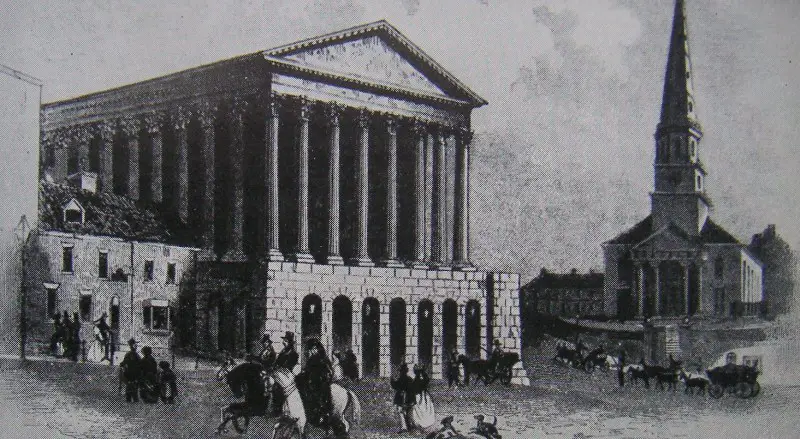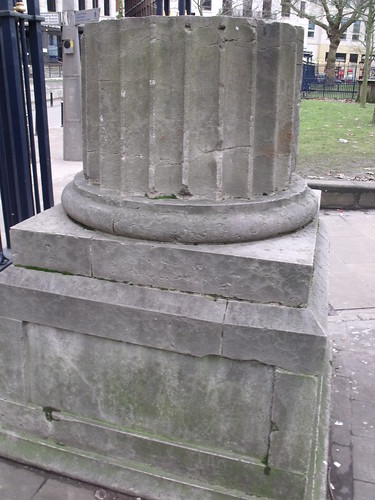-
Welcome to this forum . We are a worldwide group with a common interest in Birmingham and its history. While here, please follow a few simple rules. We ask that you respect other members, thank those who have helped you and please keep your contributions on-topic with the thread.
We do hope you enjoy your visit. BHF Admin Team
You are using an out of date browser. It may not display this or other websites correctly.
You should upgrade or use an alternative browser.
You should upgrade or use an alternative browser.
Birmingham Town Hall
- Thread starter Di.Poppitt
- Start date
john knight
signman
Thanks Bazz, it is a grand structure.
I believe that it was to be demolished for the road development 50s/60s but it was thought to be un-wise politically...it being The Town Hall and all. So a different route was taken and the Central Library and Mason's College went under the wrecking ball. Since the area was opened up by the development the TH does have much better aspects...being less crowded, it's strong features are viewed to better effect, but the lost buildings were every day functional...period, practical and more design efficient for interior space not to mention beautiful. It's not that the TH is not striking; it is and is obviously more of a landmark than the other buildings mentioned. Still, if anything had to go, I personally would have chosen differently. It still looks in great nick so maybe it could have been moved to another more open space. I would have thought that the Council House was more of a town hall in every day reality. What are town halls like in other cities? Don't the Lord Mayors have offices in them. Are the Mayors and councilors offices in this one. Anyway it's there and a visual delight seemingly.
john knight
signman
This is Brighton Town Hall, say no more.
ellbrown
ell brown on Flickr
Paradise Circus Queensway does go quite close past the Town Hall though.
Fletcher's Walk and the Birmingham Conservatoire are architectually not as good as the Victorian buildings they replaced.
I expect those will be demolished post 2013 for the redevelopment of Paradise Circus.
The Town Hall is safe though, being Grade I listed, and recently fully restored.
Fletcher's Walk and the Birmingham Conservatoire are architectually not as good as the Victorian buildings they replaced.
I expect those will be demolished post 2013 for the redevelopment of Paradise Circus.
The Town Hall is safe though, being Grade I listed, and recently fully restored.
These 3 drawings from the Architecture Magazine Vol 1 (1834) might be of interest.
https://birminghamhistory.co.uk/for...4/TownHallCongreve_St_Side_Elevation_1836.JPG
https://birminghamhistory.co.uk/forum/images2/userpics/10014/TownHallCrossSection_1836.JPG
https://birminghamhistory.co.uk/forum/images2/userpics/10014/TownHallfrom_Paradise_Street_1836.JPG
The second drawing shows the hoisting of the roof rafters using ropes attached to the ends of the tie beams and passed
And this is another 1830s drawing of the Hall with houses still alongside. Viv.

https://birminghamhistory.co.uk/for...4/TownHallCongreve_St_Side_Elevation_1836.JPG
https://birminghamhistory.co.uk/forum/images2/userpics/10014/TownHallCrossSection_1836.JPG
https://birminghamhistory.co.uk/forum/images2/userpics/10014/TownHallfrom_Paradise_Street_1836.JPG
The second drawing shows the hoisting of the roof rafters using ropes attached to the ends of the tie beams and passed
And this is another 1830s drawing of the Hall with houses still alongside. Viv.
This picture belongs here. It is also on the Paradise Street thread. Sketched from the raised forecourt of Christchurch. Allin's old curiosty shop is on the extreeme right on the corner of Congreve and Ann Street. On the far corner are the houses that were demolished to make room for the Town Hall. The row houses on the left would be a continuation of the ones next to the Town Hall on the previous post. Congreve St. runs up to the left of Alin's. There are other drawings on here in which you can just catch a little glimpse of the same far corner. On the last post in the last picture it looks like a load of coal going up towards Ann St. but not the usual two wheel carts...a four wheeler.
I found that thanks to one of the books on Birmingham I've got (Birmingham Up Town).
Memorial for Birmingham Town Hall accident victims by ell brown, on Flickr
https://www.flickr.com/photos/ell-r-brown/5317734386/
It is Grade II listed as Lower Part Of A Fluted Column.
A little more info about the Town Hall accident from the Mechanics Magazine & Journal of Science, Arts & Manufacture Vol. 19:
Badger was a Stonemason. The section of the column on the memorial in St. Philip's churchyard was part of the last workmanship of Badger. The pedestal beneath it was voluntarily wrought by his fellow workmen. The marble used was the gift of his
employers.
John Heap was a Mason & Architectural Carver. He was working as a volunteer on the Town Hall construction.
The verses on the St.Philip's memorial were composed by Miss L A Twainley, "a young lady of considerable talent, and great poetical celebrity in Birmingham".
I get the impression that this was a very shocking and significant incident at the time. Viv.
alanfisher202
master brummie
Wondering if anybody would have any idea how I could trace when or if King George V visited the Town Hall,one of my relatives may have played the piano there for him.
jennyann
Gone but not forgotten. R.I.P.
Hi Alan: It seems that King George visited Birmingham many times along with Queen Mary during the King's reign. Doesn't seem to be any obvious mention of him visiting Birmingham Town Hall, however, there may be some record in the Birmingham Archives if he did attend.
Bernard67Arnold
master brummie
Queen Mary spent a lot of holiday time at Castle Bromwich Hall, Lady Bridgeman was one of her 'handmaidens'. Not sure whether Kig George visited the Town Hall but the Prince of Wales did and some of the pen factories in the Jewellery Quarter too.
King GeorgeV and Queen Mary visited Birmingham on 22rd May1919, not sure if they went to the Town Hall. Bernard
alanfisher202
master brummie
Thank you everybody for your reply's regarding King George V visiting the Town Hall
I wonder if this 1850 Warren Blackham painting of Hill Street, looking towards the Town Hall is a view that would be possible today? It's a reminder of how high up the TH is. I think the first road across in the middle of the picture is probably Navigation Street. The painter must have been painting from a buiding quite close to where New St station would be built 4 years later. Viv.
https://birminghamhistory.co.uk/forum/images2/userpics/10014/normal_HillStreet1850.JPG
https://birminghamhistory.co.uk/forum/images2/userpics/10014/normal_HillStreet1850.JPG
Shortie
master brummie
It is possible to take a photo from this spot, but the Town Hall would not be visible because the buildings opposite and down Hill Street, are too tall. I have not seen this painting before, what a beauty it is. There are many of us on this Forum who's gt gt grandparents would know this scene very well. How lovely it would be just to spend an hour or two going back to 1850 so we could have a first-hand view. Something that will never happen, but it's one at the top of my wish list.
Hi Shortie. I expect then that many of the buildings were replaced in Hill Street I especially like the buildings on the left with the Dutch gables. I too would love to go back for an hour or two (provided you could by-pass the filth and disease of course!)  Viv.
Viv.
Shortie
master brummie
Hi Viv, oh yes, the buildings were replaced a long time ago. I think the one on Paradise Street was replaced in the 1890's and I know for certain some of the buildings on Hill Street were re-built in the 1930s', but whether they demolished later buildings, or the Dutch gables ones, I cannot say because I am not that old. The Dutch gable buildings are lovely, I have to say, and I would love to see the modern equivalent, but City planners don't want to keep things looking sympathetic to remaining buildings, they just like them to clash horribly. As for having a trip backwards, I agree with you, but I would have to have Savlon and anti-biotics on my journey!
Phil
Gone, but not forgotten.
Shortie
Just a quick word because I don't want to stray off topic, but the information I have is most of the fixtures & fittings were purchased by a pub in Worcester and they never got round to fitting them and they mostly just rotted away in a field. Obviously not the tiles, so they may be around somewhere today.
Phil
Just a quick word because I don't want to stray off topic, but the information I have is most of the fixtures & fittings were purchased by a pub in Worcester and they never got round to fitting them and they mostly just rotted away in a field. Obviously not the tiles, so they may be around somewhere today.
Phil
I wonder if these painted tiles that were on the walls of the Woodman on Easy Row were copied from that painting.
Phil
Hopefully Lyn (Astoness) won't mind me 'borrowing' this New Years Eve 1964 photo from the Old Brum Mags thread. It shows Phil's tile picture in situ in the Woodman pub. It's the one in the centre on the left of the photo. Thanks Lyn!
https://forum.birminghamhistory.co.uk/attachment.php?attachmentid=63249&d=1294857000
W
Wendy
Guest
This is so difficult as threads cross and go off topic I had to comment as what Phil said about the interior of the Woodman going to a pub in Worcestershire. The link I am attaching is interesting look at the interior of this pub. We were told it came from a manor house. I now wonder if that was true.
https://forum.birminghamhistory.co.uk/showthread.php?t=8509&highlight=Neen+Sollars
Can you please reply on the link as this thread is off topic now thanks.
https://forum.birminghamhistory.co.uk/showthread.php?t=8509&highlight=Neen+Sollars
Can you please reply on the link as this thread is off topic now thanks.
It was Hansom's birthday at the weekend. A mildly amusing extract from today's Independent newspaper containing a little known fact about peas and the Town Hall. Viv
https://birminghamhistory.co.uk/forum/images2/userpics/10014/Hansom_Birthday_22_Oct_1842.JPG
https://birminghamhistory.co.uk/forum/images2/userpics/10014/Hansom_Birthday_22_Oct_1842.JPG
Makes you realise how rich these threads are with all the info and images they contain. Good to see the images reinstated, they add so much.
Another little snippet to add. According to Midland Counties Railway by R.Allen (1840) the Town Hall "stands on richly-fluted Corinthian columns, the space underneath being used as a Market stand". I'd never heard of the area underneath the columns being put to that use in the past. But it makes perfect sense I suppose. Do the markets today make use of the area in the same way or is it now all enclosed? Viv.
Another little snippet to add. According to Midland Counties Railway by R.Allen (1840) the Town Hall "stands on richly-fluted Corinthian columns, the space underneath being used as a Market stand". I'd never heard of the area underneath the columns being put to that use in the past. But it makes perfect sense I suppose. Do the markets today make use of the area in the same way or is it now all enclosed? Viv.


